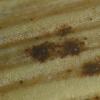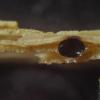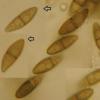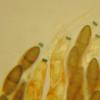
29-12-2025 08:30
Hello.A tiny ascomycete sprouting under Juniperus

29-12-2025 10:15
Hulda Caroline HolteHello, I found and collected this propoloid ascom

29-12-2025 09:38
Oskari VirtanenHi,could anyone help me identify this, I suspect P

28-12-2025 12:08
Margot en Geert VullingsThis possible Karstenia was found on the bark of d

21-12-2025 21:32
Pol DebaenstHello, Garden, Burgweg 19, Veurne, BelgiumOn 10/1

26-12-2025 21:19
Arnold BüschlenPithyella chalaudii Priou. Ist als Bryoparasit in

21-12-2025 09:32
Hello.A tiny ascomycete found embedded in wood in

18-12-2025 21:17
Pol DebaenstThe identification took me to Byssonectria deformi
Salut à tous,
On 26/3/2014 I found some little perithecia on Carex Pendula I am having some problems with:
Perithecia immersed, 0.4 - 0.5mm, ostioles barely protruding through host tissues which are blackened at the surface.
Ascospores 20.6 - 23.7 x 6.2 - 7.7 µm, 1-septate, spore walls thickened at septa, with faint to distinct logitudinal striations, surrounded by a short-lived gel sheath which is greatly thickened at the poles.
Asci with complex subapical apparatus, IKI blue
Paraphyses filiform, septate.
I looked in Ellis & Ellis and found Ceriophora palustris, which seemed a good fit apart from the lack of ascospore striations (also there is no thickening at the setpta, but this could just be an author oversight...). I couldn't find any information on the iodine reaction of this species.
I also looked in 'Revision of Amphisphaeria' Wang, Aptroot & Hyde (the striations reminded me a little of the germ slits in Cainia) and found Arecophila saccharicola which seems a better fit, though a little exotic as it's a Jamaican species described from Sugarcane.
Does anyone have have any experience of these groups? Am I going down the wrong path?
Amitiés et comme toujours, merci pour l'aide!
Nick

it rather looks like Cainia desmazieresii, but spores are a bit too broad and the substrate is Cyperaceae anyway, which may more typical for C. graminis with larger spores over 30µm length.
Is it possible to send a sample of this interesting species?
regards,
björn
Hi Bjorn,
Yes, no problem - I thought you might be interested in this one :)
There are still a dozen or so perithecia left, email me your address and I'll get the specimen in the post.
I don't think it fits with any species currently in Cainia....
Nick

Adress via email.
Thanks.
björn
Salut les amis,
Your analysis is right Nick. Arecophila is the good genus, I think
Have you compared to Arecophila striatispora, a french species. Do you observe a true clypeus on the surface, or only blackened tissues ?
It seems to be very closed.
Alain
Salut Alain,
No, I didn't observe a clypeus.
Yes, you're right about Arecophila striatispora - I compared my spores to the pictures in Wang, Aptroot & Hyde, but I think the shape is different - I thought my spores were a little more acute at the ends (?)
The specimen will soon be headed to Germany, so hopefully Bjorn will be able to make some (better) observations!
Amitiés,
Nick

sorry I missed the train.
It fits well Arecophila indeed, and Amphisphaeria/Arecophila striatispora fairly well too. Bjorn, I have a collection of A. striatispora from Basque Country on bamboo, I will send you a piece for comparison. Can you send me (again?) your postal address?
Cheers,
Jacques
I've just been adding a species page for Arecophila striatispora based on Irish collections from bamboos (see http://fungi.myspecies.info/all-fungi/arecophila-striatispora) and this seems to be rather closer to the original species concept than the fungus on Carex pendula. The ascospores are slightly curved as in Francoise Candoussau's description, and the spore halves are less strongly narrowed. But maybe the identification of the Irish species isn't right either - the ascomata have a clypeus and the ascospores appear not to have gelatinous sheaths (though this may be due to the age of the material). I think that Nick's fungus could be an undescribed species of Arecophila, and perhaps the Irish fungus is as well.....
Your opinions will be valuable....
All good wishes
Paul



